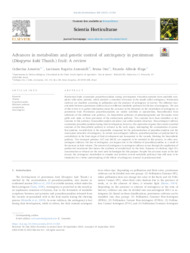Advances in metabolism and genetic control of astringency in persimmon (Diospyros kaki Thunb.) fruit: A review.
Advances in metabolism and genetic control of astringency in persimmon (Diospyros kaki Thunb.) fruit: A review.
Author(s): AMORIM, C.; ANTONIOLLI, L. R.; ORSI, B.; KLUGE, R. A.
Summary: Persimmon fruits accumulate proanthocyanidins during development. Proanthocyanidins form insoluble complexes with saliva proteins, which promote a sensation of dryness in the mouth called astringency. Persimmon cultivars are classified according to pollination and the presence of astringency at harvest. The different characteristics between persimmon cultivars lead to different metabolic pathways for the loss of astringency. The aim of this review is to gather information about the advances in the literature on the metabolism of astringency in persimmon fruit. Persimmon proanthocyanidins are mostly catechins or epicatechins, biosynthesized from substrates of the shikimic acid pathway, via biosynthetic pathways of phenylpropanoids and flavonoids, from gallic acid units, or from precursors of the anthocyanin pathway. Two enzymes have been identified as key enzymes to this pathway: leucoanthocyanidin reductase and anthocyanidin reductase. Non-astringent cultivars accumulate proanthocyanidins during fruit development, however, the expression of genes that encode essential enzymes of the biosynthetic pathway is reduced in the early stages, interrupting the accumulation of proanthocyanidins. Acetaldehyde is the responsible compound for the polymerization of proanthocyanidins and the consequent reduction of astringency. In certain non-astringent cultivars, proanthocyanidins are polymerized by acetaldehyde in the final stages of fruit development and transported to the vacuole, blocking the biosynthetic pathway. Two transport proteins, GST and MATE, are supposed to be essential in this process. In other nonastringent cultivars, the loss of astringency can happen due to the dilution of proanthocyanidins as a result of the increase in fruit volume. The removal of astringency in astringent cultivars occurs through the application of postharvest treatments that induce the synthesis of acetaldehyde by the fruit. Exposure to ethylene, high CO2 concentration or ethanol are the most used technologies for this purpose. Despite the advances made in the last decade, the astringency metabolism is complex and involves several metabolic pathways that still need to be elucidated for a better understanding of the effects of astringency removal in persimmon fruit.
Publication year: 2022
Types of publication: Journal article
Unit: Embrapa Grape & Wine
Keywords: Acetaldehyde, Deastringency, Proanthocyanidins, Shikimate pathway, Tannins
Observation
Some of Embrapa's publications are published as ePub files. To read them, use or download one of the following free software options to your computer or mobile device. Android: Google Play Books; IOS: iBooks; Windows and Linux: Calibre.
Access other publications
Access the Agricultural Research Database (BDPA) to consult Embrapa's full library collection and records.
Visit Embrapa Bookstore to purchase books and other publications sold by Embrapa.

